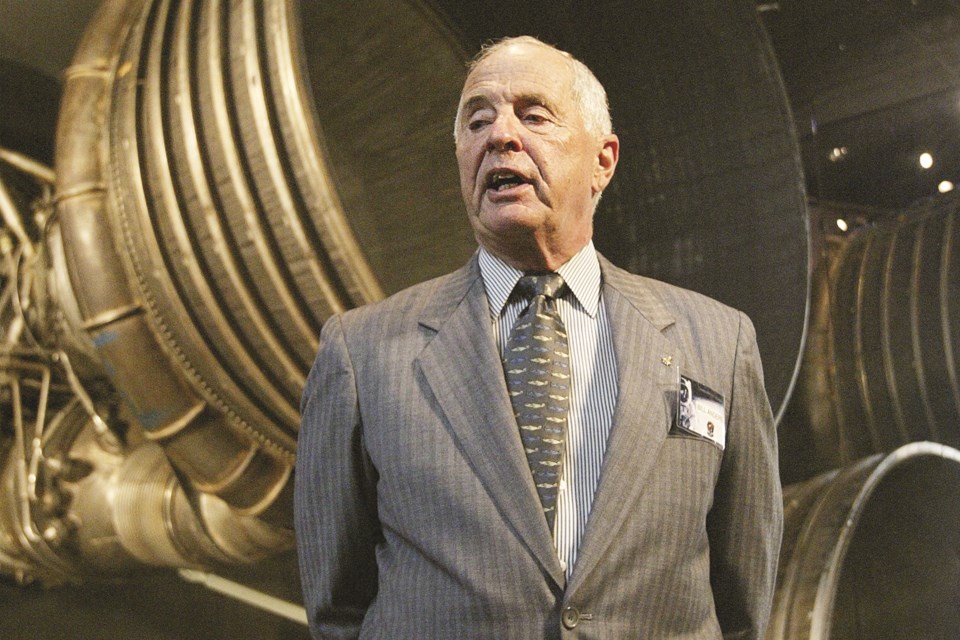SEATTLE — Retired Maj. Gen. William Anders, the former Apollo 8 astronaut who took the iconic “Earthrise” photo showing the planet as a shadowed blue marble from space in 1968, was killed Friday when the plane he was piloting alone plummeted into the waters off the San Juan Islands in Washington state.
He was 90. His son, retired Air Force Lt. Col. Greg Anders, confirmed the death to the Associated Press. “The family is devastated,” Greg Anders said. “He was a great pilot and we will miss him terribly.”
William Anders has said the photo was his most significant contribution to the space program, given the ecological philosophical impact it had, along with making sure the Apollo 8 command module and service module worked.
The photograph, the first colour image of Earth from space, is one of the most important photos in modern history for the way it changed how humans viewed the planet. The photo is credited with sparking the global environmental movement for showing how delicate and isolated Earth appeared from space.
Anders snapped the photo during the crew’s fourth orbit of the moon, frantically switching from black-and-white to colour film.
“Oh my God, look at that picture over there!” Anders said. “There’s the Earth coming up. Wow, is that pretty!”
Arizona Sen. Mark Kelly, also a retired NASA astronaut, wrote on the social platform X, “Bill Anders forever changed our perspective of our planet and ourselves with his famous Earthrise photo on Apollo 8. He inspired me and generations of astronauts and explorers. My thoughts are with his family and friends.
A report came in around 11:40 a.m. that an older-model plane crashed into the water and sank near the north end of Jones Island, San Juan County Sheriff Eric Peter said. Greg Anders confirmed to KING-TV that his father’s body was recovered Friday afternoon.
The National Transportation Safety Board and FAA are investigating the crash.
William Anders said in an 1997 NASA oral history interview that he didn’t think the Apollo 8 mission was risk-free but there were important national, patriotic and exploration reasons for going ahead. He estimated there was about a one in three chance that the crew wouldn’t make it back and the same chance the mission would be a success and the same chance that the mission wouldn’t start to begin with. He said he suspected Christopher Columbus sailed with worse odds.
He recounted how Earth looked fragile and seemingly physically insignificant, yet was home. “We’d been going backwards and upside down, didn’t really see the Earth or the Sun, and when we rolled around and came around and saw the first Earthrise,” he said. “That certainly was, by far, the most impressive thing. To see this very delicate, colourful orb which to me looked like a Christmas tree ornament coming up over this very stark, ugly lunar landscape really contrasted.”
Anders said in retrospect he wished he had taken more photos but mission commander Frank Borman was concerned about whether everyone was rested and forced Anders and command module pilot James A. Lovell, Jr. to sleep, “which probably made sense.”
Anders served as backup crew for Apollo 11 and for Gemini XI in 1966; the Apollo 8 mission was the only time he flew to space.
Anders was born on Oct. 17, 1933, in Hong Kong. At the time, his father was a Navy lieutenant aboard the USS Panay, which was a U.S. gunboat in China’s Yangtze River.
Anders and his wife, Valerie, moved to Orcas Island, in the San Juan archipelago, in 1993, and kept a second home in their hometown of San Diego. They had six children and 13 grandchildren. Their current Washington home was in Anacortes.
A video posted to Facebook by Philip Person, a resident of Orcas Island, shows the apparent crash, with the aircraft in a long dive before smashing into the water at an angle and then skipping twice while emitting plumes of smoke, water and what appears to be fuel.
Person declined to be interviewed by media outlets.
Anders graduated from the Naval Academy in 1955 and served as a fighter pilot in the Air Force. He served on the Atomic Energy Commission, as the U.S. chairman of the joint U.S.-U.S.S.R. technology exchange program for nuclear fission and fusion power, and as ambassador to Norway. He later worked for General Electric and General Dynamics, according to his NASA biography.
— With a file from the Times Colonist



